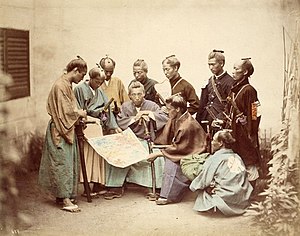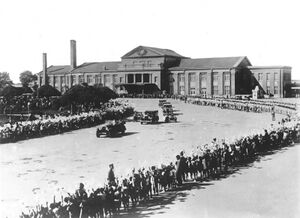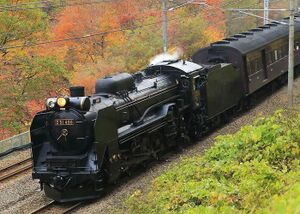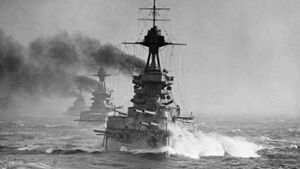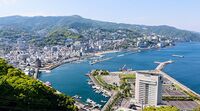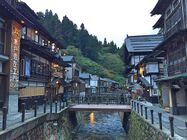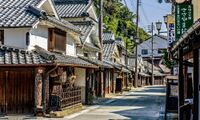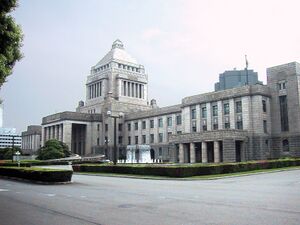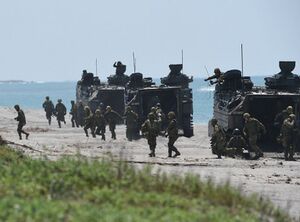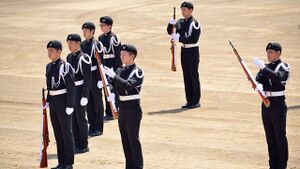Toujin Republic: Difference between revisions
m (→Military) |
(→Foreign Relations: added table) |
||
| Line 431: | Line 431: | ||
===Foreign Relations=== | ===Foreign Relations=== | ||
{| class="wikitable sortable" border="1" style="width:100%; margin:auto;" | |||
!width="15%"| Country | |||
!width="12%"| Formal Relations Began | |||
!Notes | |||
|--valign="top" | |||
|[[Kotaru Republic]]||1968||The Kotaru and Toujin Republics have had positive relations since the founding of the Toujin Republic. Various trade agreements and embassies have been established between the two nations, and both countries maintain strong ties. The Toujin Republic has 3 military bases within the Kotaru Republic, an NC Embassy, as well as a national embassy both within the Kotaru Capital, Soma. | |||
|--valign="top" | |||
|[[Rensai Conglomerate]]||1968||The Rensai Conglomerate and Toujin Republic have had a troubled past, but since the Fisherman Wars of the late 1900s, tensions between the nations have since died down. The Rensai Conglomerate acts as the primary food supplier of Toujin market's and both nations have close economic ties with numerous trade agreements dating back to the foundation of the Toujin Republic. | |||
|} | |||
==Economy== | ==Economy== | ||
Revision as of 16:50, 11 February 2020
This article is incomplete because it is pending further input from participants, or it is a work-in-progress by one author. Please comment on this article's talk page to share your input, comments and questions. Note: To contribute to this article, you may need to seek help from the author(s) of this page. |
Toujin Republic 島人共和国 (Iton) | |
|---|---|
| Motto: "平和と進歩" ("Peace and Progress") | |
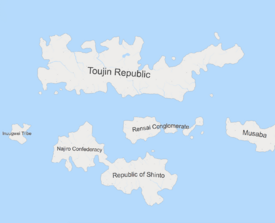 | |
| Capital | Tarabashi |
| Largest | Kobayatsu |
| Official languages | Itonese (Iton) |
| Ethnic groups | 72.6% Toujin 16.3% Rensai 4.7% Shinto 6.4% Other |
| Demonym(s) | Toujin |
| Government | Semi-Democratic Unitary Constitutional Republic |
• Head of United Congress | Koizumi Shinjiro |
| Legislature | United Congress |
| Higher Chamber of Representatives | |
| Ministry of Legislation | |
| Establishment | |
• The Toujin Revolution | 1864 |
| Area | |
• Total | 67,239 km2 (25,961 sq mi) |
• Water (%) | 4.4 |
| Population | |
• Estimate | 24,300,000 |
• 2017 census | 24,287,463 |
• Density | 360/km2 (932.4/sq mi) |
| GDP (nominal) | 2017 estimate |
• Total | $631.64 Billion |
• Per capita | $24,000 |
| Gini (2017) | medium |
| HDI (2017) | high |
| Currency | Toujin Yen(₮) (TYN) |
| Time zone | UTC-3 (AST) |
| Driving side | left |
| Calling code | +22 |
| Internet TLD | .tj |
Toujin(Iton:島人[tôuu'jin]), officially the Republic of Toujin(Iton: 島人共和国 [tou'jin kyōwakoku]), is a semi-democratic unitary constitutional republic located in the east Atlantic. The current government, the Republic of Toujin, was founded in 1864 after the Toujin Revolution as a result of the collapse of the "Toujin Alliance" The country itself was originally founded in 1536 and was simply called "Toujin". The island nation is situated on the island of Toujin, which is where the country takes its name. Toujin is neighbored by other island nations, its closest neighbors being the Rensai Conglomerate and the Republic of Shinto. The country itself resides in an archipelago in the east Atlantic Ocean, and is comprised of 12 island nations. The culmination of these Island nations is called the "Nagasaki Conglomerate" also known as the NC, and holds annual sporting events for all members of the archipelago. The Republic of Toujin has an area of 67,239 km2 and a population of 24,287,463, making it the largest and most populated island of the archipelago, and often hosts these annual events.
Toujin is officially divided into 22 prefectures, and 4 territories. Each territory elects a President, Prime Minister, and prefecture representatives in its own Higher Chamber of Representatives. The capital territory, Tarabashi, is comprised of 5 prefectures, and is the most populated territory out of the 4. Each prefecture has its own semi-autonomous government known as the Parliament of Legislation, which governs its designated prefecture. These governing bodies are run by elected officials within each prefecture, and work in tandem with representatives from the Upper Chamber of Representatives. With the capital territory having the federal government within its borders, they hold the most political power and financial support in the democratic system. Outside the democratic system in Toujin, the United Congress takes charge of national level legislature, and constitution modification. The members of the United Congress are elected by a select group of individuals comprised of government delegates and officials, as well as other special interest groups such as CEOs, and celebrities. While these individuals are technically part of a democratic process, this election is not influenced by the citizens, thus it takes place outside the democratic system. United Congressman are mandated through the "Governance Competence Examination" (GCE) and the top score from each prefecture is delegated to the United Congressman. Congressman are refreshed every four years, differing from the bi-annual elections of territorial delegates. There is also no term limit, opposed to the four term territorial delegate limit.
The geography of Toujin is harsh and heavily mountainous. Approximately two-thirds of the country's terrain is mountainous and heavily forested, and less than one-sixth of land is suitable for agriculture. As a consequence of highly mountainous terrain, the majority of Toujin citizens reside in one of the nations many cities, as the urban population accounts for nearly 80% of the nation's population. The largest of these cities is the city of Kobayatsu, with a population of 7.4 million, followed by the capital Tarabashi, and the entertainment hub Sendai.
The Republic of Toujin is considered a developed economy with a GDP per capita of $24,000 and a HDI of 0.783. Throughout the 19th century, Toujin's economy was initially built on its abundant natural resources such as coal and iron. After the "Toujin Recession of 1912", the economy shifted away from its reliance on natural resources, and towards manufacturing and other industries. As a result, the economy shifted towards secondary and tertiary sectors at a rapid pace throughout the 20th century. During the late 20th century, the economy had almost completely shifted away from natural resource production and refinement. As of 2017, More than 78% of the workforce works in the tertiary or quaternary sector, and less than 1% work in the primary sector. The nation's two highest grossing industries are entertainment and electronics.
History
The Island of Toujin remained mostly uninhabited until 1536, when an independent exploration crew discovered the island. Before this discovery, the island remained mainly inhabited by local tribes. The largest of these tribes would be the Inoquwei tribe which heavily aided early colonists of the island. The island, however, was mainly mountainous, and the majority of the local tribes relied on livestock and hunting opposed to traditional agriculture to feed their peoples. Tribes that resided on the coast relied on spear fishing to feed their people, and only had primitive boats and housing. The exploration fleet that initially discovered the island was comprised of two main ships, the Nagawa and Kagami, and a smaller supply ship, the Takemi. While the majority of exploration fleets at the time were comprised of large military ships, this fleet opted for repurposed cargo ships, and a smaller supply ship to help endure the long voyage. The ships used were modified, three masted carracks, and the supply ship was a modified two masted caravel.The two masts were designed to keep speed with the two larger ships, and the hull was designed to carry supplies and

cargo. They set sail February, 1535 from South East Asia, and made their voyage to the East Atlantic Ocean. They made supply stops in Europe, and eventually found the Island of Toujin June, 1536. The total voyage lasted nearly a year and 4 months, yet the crew miraculously reported zero casualties. The captain of the Nagawa, Ryouuske Toujin named the island after his family name, and began colonizing the newfound island. He initially planned for the island to be an unaffiliated territory, but later planted roots that eventually led to the creation of a formal government. After colonization began, Captain Toujin sent back the Kagami and Takemi to bring more supplies and colonists, and to bring his wife and family to the newfound island. Thus founded the beginning of history for the island of Toujin, and the long history of its people.
Early History
Early Colonies on the island of Toujin struggled to secure sources of food and fresh water. Attempts to begin agricultural production were short lived, as much of the land was uneven and difficult to plow. During the winter of 1536, the local Inoquwei tribe helped support the colony of Koji during these harsh months, and taught them how to spear fish. Indebted to the local tribes, colonists shared their modern technologies with the natives, such as basic shipbuilding, clocks and timers, as well as the compass. These initial exchanges helped shape the relationship between the colonists and local tribes. The two initial colonies that began expanding were the Koji and Masagawa colonies. In the year 1540, the local reported population of the Koji colony was 2,359 and the reported population in the Masagawa colony was 1,083. The Masagawa colony was located in the mountains, and heavily relied on hunting for food. The Koji colony was located on the eastern shore, and in tangent with the Inoquwei tribe, provided food through various fishing methods such as spear fishing and net fishing. These two colonies were about 27 km apart, and often traded with each other. In 1563, the Toujin League of Colonies aka the TLC was founded to give structure to the newfound colonies. Led by the initial founder, Ryouuske Toujin, the TLC comprised of 6 colonies, and approximately 10,000 people. The TLC helped establish basic infrastructure, as well as a small military designed to prevent crime and keep the peace. The TLC established their headquarters in 1564 at Tarabashi, one of the newer colonies in Toujin.
In the late 16th century, the population of the colonies began to boom. From 1575 to 1603, the population more than doubled. This was partly due to a large influx of colonists, but also due to the more readily access to food and fresh water. Food production powerhouses such as the Koji and Johsai colonies has massive fishing vessles, and provided the majority of the food for the island of Toujin. Apart from food production, shipbuilding became a mainstay industry for coastal colonies. Due to Toujin's abundant iron deposits in the mountainous regions to the north, many colonies began to mine iron, and trade those resources for food with the coastal colonies. The rise of shipbuilding allowed the people of Toujin to further explore the archipelago, and colonize other islands. In 1641, the TLC had grown from a small organization of a few colonies, to a pseudo nation comprised of 24 cities and towns. The population of colonies under the TLC had grown from around 10,000 to 143,205. In a short 80 years, the population of the TLC had grown by a magnitude of 14.
In response to the rapidly growing size, the TLC had enacted various policies to help fund and expand the TLC's newfound responsibilities. In 1645, the TLC had a standing army of around 2,000 soldiers, and 14 ships, as well as 3 fortified camps. In 1647, they introduced a central currency, the Toujin Yen, and began evolving more into a central government. From 1650 onwards, the TLC transitioned from the Toujin League of Colonies to the Toujin Alliance and began taking the role of an official central government. The Toujin Alliance declared itself a sovereign nation on September 24th, 1651. It comprised of 3 territories, all located on the Island of Toujin, and all run under the Central Toujin Government (CTG). It officially transitioned its military from a local peace keeping force into a national army, and established its two branches, the army and navy. In addition, the CTG established various other government organizations such as the National Reserve, Toujin Taxation Bureau, and National Trade Organization. Thus marked the beginning of the Toujin Alliance, and the island's transition from colonies to a full fledged nation.
Rise of the Toujin Alliance
The Toujin Alliance was founded in 1651, and comprised of 3 territories, all located on the Island of Toujin. These territories included the capital territory, Tarabashi, as well as the Johsai and Hajimari Territories. The Toujin Alliance was an autocracy, and was rules by the Central Toujin Government (CTG). The CTG was run by Chairman Hiro, as well as his three appointed Government Officers. Chairman Hiro reserved control over the Federal Reserve, National Army and Navy, as well as the Toujin Taxation Bureau. Despite his overwhelming power over the government, Chairman Hiro was well liked among the people of the Toujin Alliance. His efficient implementation of government regulation was appreciated among the trading community, and his tendency to spend government funds on public infrastructure contributed to a high approval rating. He placed emphasis on economic strength of the nation, and founded numerous trade schools including the prestigious Sendai Technical Institute(Iton: 仙台技術機関 [Sen'dai gijǔtsu kikán]).
The Toujin Alliance heavily relied on importing food to sustain its growing population. As of 1722, the nation's population had swelled to 1.4 million, and its food production could only provide for roughly 50% of its residents. Toujin's lack of agricultural production meant that the majority of food produced by the nation were either livestock or fish. In order to sustain its economy, the National Trade Organization of Toujin placed emphasis on exporting goods to nearby nations. The Island of Rensai, Toujin's closest neighbor, had a developed food production sector and was Toujin's main source of imported food. To pay for this massive importation of food, Toujin relied on exporting goods like iron, coal, and sophisticated ships, as Toujin's ship building industry was extremely developed. However, in the late 1700s, many of Toujin's iron mines began shutting down.
Toujin's natural iron supply had dried up in 4 of the 6 major iron producers on the island. Only the Takegawa and Nijima iron plants had maintained production efficiency over 80%. The other 4 plants had an average production efficiency of 22%, and eventually led to all 4 being shut down. The 4 plants that shut down were responsible for 70% of the nation's iron production. This sudden decrease in iron production caused the economy to be sent into a severe recession. This recession caused numerous shortages across the island, and delayed the island's industrialization in the late 1700s. Toujin's main industry, shipbuilding, was also severely affected by iron shortages. The number of ships produced annually fell from 132 to just 40, causing the industry to falter. As ships were one of the nation's main exports, the country struggled to continue importing food. The TCG urged its citizens to produce more food domestically, anticipating a severe food shortage. Through programs such as the Toujin Agricultural Incentive Act, the TCG provided financial incentives for its citizens to expand the agricultural production of the country. However these attempts were unsuccessful. The natural mountainous geography of the island made it nearly impossible to expand agricultural production. Despite heavy incentives from the TCG, agricultural production only increased 4% from 1780-1786. On top of an impending food shortage and economic recession, many neighboring countries formed trade agreements to economically exploit the food starved nation, and eventually led to the collapse of the Toujin Alliance.
The Toujin Revolution
The aftermath of severe iron shortages led to major food shortages across the nation. Initially, the TCG attempted to secure trade deals with its neighbors, offering bonds and future payment. However, many neighboring nations such as the Rensai Republic and Shinto Confederacy were wary of entering trade negotiations with a nation in such economic downturn. As a result, many negotiations fell through, and the TCG struggled to find trading parters in which to import food. Eventually, the Toujin Relief Fund was founded in 1857 aiming to help raise money to feed the people of Toujin. However, the fund ultimately failed due to lack of contributors across the nation. This was mainly due to the impact already being felt by the people of Toujin. Many families were beginning to struggle to feed their families, and discontent across the nation began to rise. In the year of 1860, over 2,000 people died to starvation, and an estimated 13,000 were deemed extremely malnourished. Numerous cities were forced to distribute food sparsely, and the economic production of the Toujin Alliance grinded to a hault. In response to this severe lack of food, many workers went on strike, further damaging the economy.
As a result of the massive food shortages across the nation, many uprisings began to sprout across the nation. Initially these were mainly peaceful protests, and involved pleads to the government to provide its people with food. However, these peaceful protests eventually devolved into violent riots, calling for the downfall of the government. Many food stockpiles had to be defended by military forces to prevent Citizens from raiding the stockpile. In addition to massive food shortages for the people of Toujin, the TCG was also struggling to feed its own soldiers. Numerous supply lines across the nation became inactive due to increasing riots along the roads. Food supply trucks were constantly being raided, even with military escort, and the TCG as a whole lost control over numerous military bases. In addition to this, fishing boats were raided for food, and began to require naval escorts when going out to sea. The people of Toujin became more desperate and riots began to spiral out of control. Citizens claimed their government was incompetent and uncaring of its people. Violent riots began to sprout across the nation and lead to many event further decimating the Toujin economy. Riots in the port of Hajimari became extremely violent and dangerous. The largest riot was in 1863 and was called The Riot of the Hajimari Redistribution Center. The riot caused over 300 deaths, and many ships and buildings being pillaged and razed. The military defending the redistribution center was easily overrun, as many soldiers defected due to their own lack of food and poor living conditions. As a result, many coastal military bases failed to come to the aid of the Hajimari governing body, which resulted in TCG control being forfeited to the rioters. Out of the 12 platoons stationed near Hajimari, only 2 came to defend the city, while 7 defected and 3 remained inactive during the riots. The defector military platoons quickly raided their own food stockpiles, and began the Toujin Freedom Fighters under regional Captain Tojima Akamatsu. The rebels marched towards the capital, Tarabashi, aiming to overthrow the TCG. While this was happening, the TCG ordered its own most trusted military battalion, the 2nd Battalion, as well as the Royal Guard to defend the TCG governmental building, as well the citizens of Tarabashi.
The Toujin Freedom Fighters began amassing an army, consisting of volunteer fighters, as well as defecting soldiers. Akamatsu and his men went to various villages and towns on the way to Tarabashi, recruiting men as he went. The people were in favor of his Freedom Fighters, and offered support with food, water, and shelter. While Akamatsu was determined to overthrow the current government, he refrained from forcing men into his ranks, and absolutely avoided harming citizens as they were the ones he was fighting for. With an army of nearly 16,000 troops, Captain Akamatsu prepared his invasion of the capital. Due to food shortages across the nation, many of his soldiers were starving as well. In light of this, the Freedom Fighters sought to quickly end the revolution and restore trade agreements to import food once more. With the defending force only consisting of 2,000 2nd Battalion soldiers and 250 Royal Guardsmen, the capital Tarabashi was easily overrun by Akamatsu and his forces. The Defending forces surrendered before the fighting even began, and laid down their arms. The Freedom Fighters began to raid food stockpiles across the city to feed their troops. After the last stockpiles were pillaged, the Freedom Fighters marched into the capital building, and demanded the Chairman and other government leaders to stand down. Akamatsu demanded that the chairman shall forfeit the reigns to the country to him.
Akamatsu and his men annexed the Toujin Alliance and looked to the people to create a new government that will put the well being of its citizens first. He began to send his men to far away nations asking for aid and promised the people of Toujin that within a year, they will all be eating happily once more. During the initial annexation of the TCG, Akamatsu was popular amongst his men as well as the people. His ideals were righteous and he looked to help his citizens more than anything. He began many food aid programs in the country to try and relieve the starving people. He demanded that wealthy families help feed the people, and used military force when necessary. His determination to stray away from the previous rules led to the disbandment of the Toujin Alliance. He declared that the current government structure was oppressive and only served the self interest of its rulers. He pushed for a democratic government, and planted the foundations for the new Toujin Republic.
The Founding of the Toujin Republic
Following the downfall of the TCG, a new government rose in its place. However, the name Toujin Alliance stayed for decades after the fall of the TCG. After the Toujin Revolution, many soldiers swore allegiance to Akamatsu as he was their leader. Akamatsu swore to reform the government and prevent the tragedy that had befallen before them. Over the next couple of decades, Akamatsu gathered government officials across the nation to discuss and form a new government system that would replace the old autocratic nation.
During this time period, the temporary government was run by the National Trade Organization who took care of funding public policy, the military, and most importantly form new trade agreements with foreign parties. This, however, would lead to many unfavorable trades for the people of Toujin, as the National Trade Organization was desperate to acquire new food import deals, and auctioned off various government assets to do so. This led to many problems in the future for the Toujin government, especially in terms of supply line infrastructure and government assets. After the new government was formulated, Akamatsu and 40 delegated officials officially founded the Republic of Toujin on August 8th, 1886. After the nation was officially founded, there were many parades celebrating the foundation of the Toujin Republic, including one outside the old house of parliament. All national organizations and power was handed back to the Republic of Toujin, and the newly found government began its first election cycle of its history. As a result of the newfounded government, the country was split into 4 territories and 20 prefectures. Later, the Sendai and Wakatori prefectures were added making the entire territory comprised of 22 prefectures. The government was founded at the turn of the industrial era, and the economy was eager to industrialize. Early economic policy mainly included incentives to build numerous factories across the nation, and begin industrializing the entire nation of Toujin.
Industrialization of Toujin
The industrialization of Toujin was rapid, and sudden. After the founding of the Toujin Republic, the economy was eager to industrialize. Due to massive food shortages throughout the Toujin revolution, industrialization was almost non existent in the economy. However, due to recent trade agreements, food shortages were solved and the economy could begin its recovery, and eventually its growth. The main industries in Toujin shifted from harvesting natural resources to manufacturing and producing secondary goods. Their proficiency in ship building was not lost, as many factories were dedicated to creating parts for ships. Shipyards in Hajimura and other port cities were converted to begin producing ironclads, in order to modernize the Toujin Navy as well as the nation's trade ships. Railroads were completed across the nation, and further interconnected the nation's territories. In addition to industrialization in transportation and ship building, other forms of industrialization influenced Toujin way of life. Telegraph stations became common place in cities, and the Toujin National Mail Service was founded.
Toujin's economy began to take shape in the early 1900s. The country began to become proficient in a variety of manufacturing processes, such as steam engines, ship building, and steam trains. The Toujin economy used these proficiencies to export their newfound products to nearby countries such as the Shinto Republic and Rensai Conglomerate. However, despite these economic advances, poor trade deals made during the wake of the national food crisis continued to slow down the economy. Exports were at a record high, yet the quality of life within the nation had barely improved. The United Congress of Toujin sought to improve quality of life, and attempted to renegotiate trade agreements with neighboring countries, to no avail. In the year 1911, the nation's iron reserves had completely dried up, leading to the greatest economic recession in Toujin History.
Toujin Recession of 1912
The Toujin Recession of 1912 was a combination of rapid industrialization, and complete lack of natural iron resources. In addition to already importing a large quantity of food, these trade agreements were heavily unfavorable to the Republic of Toujin, and took a major toll on the economy. Having to import iron and steel put further strain on the economy, eventually leading to economic collapse. Shipbuilding, still one of the nations leading industries, had to hault production entirely until outside sources of iron were secured. This in addition to numerous factories being shut down for the very same reason, led to the economic production of Toujin to fall over 50%. This massive fall in economic production led to numerous investors in the country to begin pulling out funding from government bonds and shares. The United Congress began to look for help from its neighbors, and eventually secured foreign aid from the Kotaru Republic and the Najiro Confederacy. However, the fall in economic production still had repercussions for government spending and support.
Fall in economic production led to massive unemployment across the nation. The unemployment rate rose from 7% to 20% in 6 short months, and many families became homeless due to lack of a job. This tied in with expensive imported food led to many families going hungry without secure access to food. The United Congress took action immediately following the spike in unemployment. Public works project went underway such as the Yakamatsu bridge, to try and spark the economy out of recession. These public work projects helped alleviate the unemployment rate back to 12%. However this put more strain on the economy, as government support became heavily limited due to the costs of these public work projects. The Toujin Republic put forth many aid programs to help alleviate food shortages and feed the hungry. In the year 1913, the government had accrued massive debt, but the recession began to subside. Foreign iron imports were secured from the Kotaru Republic, and shipping routes began to take shape.
Having to import iron, the Toujin economy shifted to heavily rely on manufacturing to produce in its economy. Luckily, the country's massive coal reserves remained operational throughout the recessions, lessening the blow as coal took over as the country's main export. This coupled with the country's efficient rail network made the impact of food shortages and unemployment less severe. While the government had accrued a large amount of debt, the United Congress set forth economic plan to try and bring the Republic of Toujin from a wavering, weak economy towards a strong and robust one. The Toujin Recession brought to light the extremely unfavorable trade agreements that had been previously made following the Toujin Revolution, and angered the people. Many protested for the government to re-evaluate these trade agreements, and forge new ones with more favorable trade conditions. The United Congress and the National Trade Organization of Toujin sought to reform trade agreements with the Rensai Conglomerate, but to no avail. This led to heated tensions between the two nations, and eventually led to The Fisherman Wars of the 1920s.
The Fisherman Wars
Following the Toujin Recession of 1912, food shortage became a prevalent issue throughout the Toujin Republic. Due to unfavorable trade agreements and massive public works projects, the government was in substantial debt, and could do little to alleviate food shortages. The public's reaction to the decreasing supply of food was to increase domestic food production by any means necessary. Desperation grew among the people of Toujin, and eventually led to the people expanding fishing routes along the southern coastline. Fishing fleets expanded their fishing zones, infringing on the Rensai Conglomerate's own fishing territory. This led to territorial disputes among the citizens of both countries, and eventually led to their government counterparts getting involved.
Both governments attempted to resolve initial disputes through peaceful means. However, the Toujin Republic's rough history with the Rensai Conglomerate led to many proposals beings rejected between the two nations. The Toujin government blamed the Rensai leaders for much of their food shortage and economic downturn. They pointed to harsh trade agreements, and unfavorable terms between the two nations as main causes to blame. The people rallied behind their government, and the Toujin Republic began to demand more favorable trade conditions, and food supplies. When the Rensai Conglomerate rejected the offer, the Toujin people began to demand war. Due to the Toujin Republic's lack of iron deposits, they looked to nearby nations for aid. The Kotaru Republic, previously having offered food aid to the country, also supplied Toujin shipyards with iron to sustain the Toujin Navy. With Toujin's massive ship building infrastructure, the Toujin Navy mobilized, and began to defend their newfound fishing routes near the Rensai Conglomerate.
The Toujin Navy was comprised of 6 fleets, totaling over 40 ships. Each fleet was comprised of a combination of battleships, submarines, and support ships, and were all constructed with steel. The Rensai Conglomerate's fleet, however, was not as advanced as the Toujin Navy. With only 1 modern fleet to its name, and 2 outdated pre industrial era fleets, the Rensai Conglomerate conceded its naval territory to the Toujin Navy. During August of 1920, the Toujin Navy began patrolling near north Rensai territory, and threatened to open fire on coastal batteries if any action was to be taken by the Rensai military. The Rensai coastal batteries initially held their fire, but after the burning of several lighthouses and navigational buildings, the Rensai coastal defensive batteries were ordered to open fire on Toujin forces. After several conflicts near Najima, and Kokatsu, the Toujin Navy had taken minor casualties in the 2nd and 5th fleet. The Rensai Coastal batteries, however, had received retaliative fire, and suffered heavy losses both in equipment and men. The Toujin Navy wrested total control over naval passageways, and shut off outside aid to and from the Rensai Conglomerate. In the year 1922, the Rensai Conglomerate agreed to renegotiate trade agreements regarding food and supplies, and eventually reached an armistice in April of 1922.
The aftermath of the war mainly consisted of newly forged trade agreements, and hostile relations between the two war torn nations. The Rensai Conglomerate was forced to accept unfavorable trade deals, and continuously supply the Toujin Republic with food and supplies in return for very little profit. The Toujin economy, however, was alleviated by these newfound trade deals, and began to grow both in productivity and production capacity. The aftermath of the war sparked an economic boom in the Toujin Republic, and led to record low unemployment, record high standard of living, and consistent economic growth for decades to come. The Toujin Navy expanded from 6 fleets to 11, and began expanding various other industries such as weapon manufacturing and general machinery. The War had turned the tides and relationship between the Toujin Republic and Rensai Conglomerate for many years to come, and had given the Toujin economy room to grow into the future.
Contemporary History
Following the Fisherman War of the 1920s, the economic prowess of the Toujin Republic came to fruition. With food shortages being alleviated with trade agreements with the Rensai Conglomerate, the United Congress sought to expand Toujin influence throughout the Nagasaki Archipelago. Throughout the contemporary period, numerous major events shape the current state of Toujin politics. During the 1900s, the Toujin Republic forged new alliances with its neighbors, solidified its economic presence in the archipelago, and further transitioned its economy away from the primary sector, and towards the more profitable and sustainable secondary and tertiary sectors.
Inuugwei Civil War
During 1978, the Inuugwei tribe underwent a bloody civil war between the two chieftains, Palkatan and Atatiwa. The Palkatan loyalists occupied the majority of the island, and sought aid from the Toujin Republic to help maintain control of their territory. In response, the Toujin Republic sent forces to the small Inuugwei island and provided military aid to the Palkatan loyalists. The Toujin army helped Palkatan suppress rebels and eventually suppressed and resolved the conflict in 1979. Through numerous decisive victories throughout the eastern side of the island, Toujin forces were able to overwhelm Atitawan rebels and seized control of key territories across the nation. Having deployed the 22nd and 24th battalion, the Toujin forces were able to not only protect Inuugwei civilians, but expand their zone of control throughout the island, and thoroughly suppress the Atatiwan insurgents.
During the aftermath of the war, Palkatan tribesmen swore allegiance to the Toujin Republic, and the two nations formed a favorable political stance towards one another. The United Congress established embassies in the Inuugwei tribe, and helped further develop diplomatic relations between the two nations. The Inuugwei tribe established favorable trades with the Toujin Republic, providing food and supplies in return for modern weaponry and vehicles. This mutual exchange helped propel both economies and drastically increased the rate of industrialization throughout the Inuugwei tribe. With modern weapons and military vehicles, the Palkatan tribesmen were able to maintain control over their territory, and eventually increase general economic output throughout the tribe. As a result of these developments, the Inuugwei Tribe was officially invited to the Nagasaki Conglomerate in 1994, and to this day hold one of the 12 seats on the Council of Nations.
Toujin Kotaru Treaty of 1982
The Kotaru Republic and Toujin Republic share a history of supportive and beneficial trade agreements. Both nations had supplied aid to one another at some point in time, and this had helped forged positive relationships between the two nations. Ever since the Toujin Depression in 1912, the two countries had shared political alliances, and in 1982 these alliances were solidified in the Toujin Kotaru Treaty of 1982. Both nations formed a defensive pact as well as an economic alliance, furthering the development of both economies. Toujin agreed to trade weapon manufacturing details and sophisticated machinery in return for food and iron supplies from the western island nation. These trade agreements stood the test of time and are active as of 2017. The Treaty solidified the already positive relationship between the two republics, and to this day mark one of the more powerful alliances within the Nagasaki Archipelago, between two military and economic powerhouses.
Founding of the Nagasaki Conglomerate
In 1992, 10 nations within the Nagasaki Archipelago came together to form the Nagasaki Conglomerate also known as the NC. The newfound organization was designed to act as a political platform for countries within the archipelago to settle their disputes in a civil manner. Annual events were to be held with all nations as acting participants, and led to the improvement of international relationships between the members of the conglomerate. Later in 1994, the Inuugwei tribe and the Naguwei tribe were both added to the NC bringing the total up to 12 nations in the conglomerate. All members of the NC are given representation in the Nagasaki Peace Council, and are all given platforms on which to express opinions on political topics. There are NC headquarters in all 12 nations, but the main base of operations resides in Tarabashi, the capital of the Toujin Republic. Due to this, many annual events are hosted by the Toujin Republic including the annual Inter-Archipelago Sports Festival hosted by the NC every year. The Sports Festival contains numerous sporting events such as track and field, swimming, tennis, and the widely popular sport of baseball. The sporting event typically lasts upwards of a month, and takes place in various locales. The event is said to bring the nations closer together and celebrate the advances the archipelago has made in its long and rich history.
Geography
The Island of Toujin is a mountainous, temperate island which resides in the Northwest quadrant of the Nagasaki Archipelago. Its closest neighbors are the Island nations of the Rensai Conglomerate, The Najiro Confederacy, and the Republic of Shinto. The Island is known for its heavily mountainous terrain, and lack of agriculturally developed land. To compensate for lack of an agricultural industry, the coast of the Toujin Republic is full of various species of fish such as Atlantic Cod, Bass, and the unique native species, the Nagasaki Turbot. Despite being an Island Nation, the island of Toujin is quite large, and contains many inland cities within the mountainside. With an area of 67,239km2, the island of Toujin is the largest Island within the Nagasaki Archipelago by total area. Its highest point is Mount Kujo at 3,861 meters, and its lowest point is the valley of Rike, 74 meters below sea level. 64% of the nation's entire landmass is classified as mountainous, and only 13% is considered plains or flatlands. The majority of Toujin's population resides in coastal cities, such as Kobayatsu or Port Hajimari. These cities act as economic hubs, and attract numerous immigrants and citizens migrating from the countryside. All 4 territories within the Republic of Toujin contain at least one coastal city, and the majority of prefectures reside along the coastline as well. Ocean territory accounts for 4% of Toujin's total area, and has a history of being heavily disputed with the nearby nation, the Rensai Conglomerate.
The Island of Toujin is divided into 4 major territories (including the Capital Territory Tarabashi), and 22 prefectures. Each prefecture is run by a local governing body, mandated either through democratic voting, or federal mandate by the United Congress. Each territory has its own parliamentary body, and are united by the federal government, the United Congress. While local government controls the majority of authority over legislation and regulations, the United Congress reserves the power to overrule and local governmental decree. The federal government resides in the capital, Tarabashi, which resides in the southeast coastline of the Toujin Republic. While the prefectures are united under a central government, they all have unique geographical features. The island of Toujin has a relatively limited biome diversity, as over 75% of the country's landmass is mountainous or coastal. Only 1/6th of Toujin land is deemed "fit for agricultural production". This limits Toujin's agricultural production capacity considerably, as there is very little fertile land within the island. Lack of agricultural production within the country causes the majority of domestically produced food to be fish or seafood. The fishing industry accounts for 68% of the country's food production, and is one of Toujin's leading industries. Due to the nature of being an Island nation, and the wealth of ports and coastal cities, the people of Toujin turn towards fishing to help supply the country's supply of food.
Climate
According to the Köppen climate classification system, the Toujin Republic's climate is classified as Cfb or temperate oceanic climate. Due to the mountainous nature of the island, the average altitude is well above average, and dictates the landscape throughout the nation. The island rarely experiences snowfall at sea level, and occasionally receives small amounts of snow past 800 meters of altitude throughout the mountainside. Northern and southern Toujin have relatively different climate, and temperature ranges can differ considerably between inland and coastal regions. In northern Toujin, temperature ranges are typically 15-22°C in the hotter months, and can reach as low as -8-4°C in the winter. In the south, however, temperature ranges are considerably higher at 20-28°C in the hotter months, and 5-14°C in the winter. While temperature ranges are consistent among certain regions of the country, the general temperature range fluctuates throughout the year. However rainfall across coastal cities is relatively consistent at around 1000-1250mm.
In the mountains, however, annual rainfall fluctuates drastically, and dependent on the regions, rainfall figures could range from 250-900mm. In terms of hurricanes, the island of Toujin is relatively resistant to hurricanes due to its temperate climate. In addition, neighboring landmasses help deter possible hurricanes from forming due to constant landmass interference.
The capital of Toujin, Tarabashi, has generally cooler climate than the rest of the country. While temperatures reach as low as -2°C during the winter, it rarely ever snows within the territory. Throughout 2002-2018 the Tarabashi Climate Committee wrote a thorough climate report detailing the general fluctuations of temperature, humidity, sunlight hours, and other details regarding the climate within the city of Tarabashi. Temperature fluctuates considerably throughout the year, with lows and highs being up to 15°C different. Throughout the winter, the temperature rarely goes above 10°C, and during the summer, it typically caps out at 25°C. In terms of precipitation, August is considered the rainy season during the year, as it accrues far more rainfall than any other month, around 50mm more. This in turn, affects August's sunshine hours, as rainfall drags average sunshine hours to below 205. The record high temperature was recorded in 2017 in Tarabashi at 30.6°C on July 2nd. It remains as the highest temperature recorded in Toujin climate history, and reflects a general increase in temperature levels over the past few decades.
| Climate data for Tarabashi – capital of Toujin (Tarabashi Climate Committee) 2002–2018. | |||||||||||||
|---|---|---|---|---|---|---|---|---|---|---|---|---|---|
| Month | Jan | Feb | Mar | Apr | May | Jun | Jul | Aug | Sep | Oct | Nov | Dec | Year |
| Record high °C (°F) | 17.6 (63.7) |
19.0 (66.2) |
23.5 (74.3) |
27.3 (81.1) |
26.8 (80.2) |
28.7 (83.7) |
30.6 (87.1) |
28.0 (82.4) |
24.9 (76.9) |
22.4 (72.3) |
18.5 (65.3) |
17.2 (63.0) |
30.6 (87.1) |
| Average high °C (°F) | 14.6 (58.3) |
17.1 (62.7) |
17.4 (63.4) |
23.6 (74.5) |
23.5 (74.3) |
25.6 (78.1) |
27.2 (80.9) |
24.6 (76.2) |
22.6 (72.7) |
18.9 (66.1) |
13.6 (56.4) |
10.7 (51.2) |
25.1 (77.1) |
| Daily mean °C (°F) | 5.7 (42.2) |
6.9 (44.4) |
9.4 (49.0) |
11.4 (52.6) |
13.6 (56.5) |
20.5 (68.9) |
23.3 (74.0) |
19.8 (67.7) |
16.1 (60.9) |
12.3 (54.2) |
9.4 (48.9) |
6.7 (44.1) |
16.8 (62.3) |
| Average low °C (°F) | −2.0 (28.4) |
−2.4 (27.7) |
1.6 (34.8) |
1.8 (35.3) |
8.1 (46.5) |
11.7 (53.0) |
11.6 (52.8) |
7.9 (46.2) |
4.5 (40.1) |
1.2 (34.2) |
0.9 (33.7) |
−2.8 (27.0) |
8.3 (46.9) |
| Record low °C (°F) | −9.9 (14.2) |
−8.0 (17.6) |
−6.1 (21.0) |
−2.7 (27.1) |
−0.1 (31.8) |
3.0 (37.4) |
5.0 (41.0) |
3.1 (37.5) |
2.8 (37.0) |
1.2 (34.1) |
−7.1 (19.3) |
−8.7 (16.4) |
−9.9 (14.2) |
| Average precipitation mm (inches) | 82 (3.22) |
98 (3.87) |
94 (3.72) |
106 (4.17) |
115 (4.52) |
145 (5.71) |
158 (6.21) |
213 (8.38) |
155 (6.09) |
109 (4.31) |
99 (3.88) |
59 (2.33) |
1,433 (56.41) |
| Average precipitation days (≥ 0.01 inch) | 14 | 13 | 14 | 15 | 13 | 16 | 17 | 20 | 16 | 14 | 12 | 8 | 172 |
| Average relative humidity (%) | 58 | 59 | 61 | 64 | 69 | 72 | 74 | 76 | 73 | 71 | 68 | 54 | 68 |
| Mean monthly sunshine hours | 142.9 | 144.5 | 185.7 | 228.1 | 248.1 | 257.2 | 281.0 | 204.1 | 220.1 | 197.5 | 170.3 | 142.5 | 2,492 |
Politics and Government
The Toujin Republic is a Semi-Democratic Unitary Constitutional Republic founded in 1864. The Government is split into 3 main levels, each governing at different scales. The Ministry of Legislation is a conglomerate of local administrations that govern prefectural territories. The Higher Chamber of Representatives are semi-autonomous governments that govern at the territorial level, and have authority regarding public infrastructure, police, military, and general public services. The highest level of government is the United Congress, which governs at the federal level. The United Congress has full authority to override any previous legislation, and has the ability to make changes and alteration to the Toujin Constitution when a 2/3rds majority vote is reached. They also maintain foreign relations, military strategy, and pass federal level legislation. The current head of the United Congress is Koizumi Shinjiro, who was inaugurated in 2018.
Government Structure
The Toujin Republic's government is separated into three main bodies of governments. The first is the Ministry of Legislation. The Ministry of Legislation is comprised of local authorities from each prefecture, and primarily focuses on local legislation, regulation, and localized issues. While given power over their local governing population, they are under the control of the Higher Chamber of Representatives. The Higher Chamber of Representatives are comprised of reps from each territory, as each territory has their own Chamber. These Higher Chamber are in charge of governing the territory under their jurisdiction and maintaining order within their prefectures. They are in charge of funding distribution, public works projects and maintenance, infrastructure, public services, and welfare programs within their territory. Above the Higher Chamber, is the United Congress which acts as the federal body of governance in the Republic of Toujin. The United Congress holds full authority over governing bodies beneath their jurisdiction, and maintain responsibilities regarding foreign policy, constitutional alterations, federal level legislation such as tax rates and conscription, as well as control over the Toujin Military.
Ministry of Legislation
The Ministry of Legislation is a democratically elected body of governors that passes and maintains legislation on a prefectural level. Each governing body is responsible for the prefecture under their jurisdiction, and has authority to pass legislation regarding police and security, infrastructure, localized subsidies, hosting public events, and carrying out legislation passed through the Higher Chamber of Representatives, or the United Congress. Each Ministry is comprised of a Governor, a council of advisors, a board of citizenry, and a board of education. The Ministry is responsible of maintaining order and facilitating progress within its jurisdiction. Governors are elected via bi-annual election, and the term limit is 2 terms. Governors, however, are allowed to serve more than 2 terms if they are elected to a higher position of government such as the Higher Chamber of Representatives. The council of advisors is appointed by the acting Governor and work to advise legislative decisions throughout the term. In terms of legal power, the Governor is also permitted to remove and appoint new attorney generals at their discretion. However, if the Governor is deemed unfit or under investigation, this process may be revoked by higher positions of authority. In addition, the United Congress may forcibly remove any members of the Ministry at their full discretion, but this power is reserved only for extreme cases of incompetence or malpractice.
In Tarabashi, the Ministry of Legislation and the Higher Chamber of Representatives have an annual meeting regarding legislation and strategy on how to move forward as a nation. This inter-governmental meeting is facilitated by members of the United Congress, and its aim is to have both levels of government operate in unity. In addition, all Ministry of Legislation governors hold an annual meeting within their territorial capitals, aiming to discuss local problems, complications, and seek concise and efficient solutions. The Ministry of Legislation also meets once a year in the Central Ministry Building located in the capital, Tarabashi. This meeting involves conversations with the United Congress regarding local events, requests for funding and aid, as well as any notable legislative differences within the prefectures. This meeting takes a full week, with numerous politicians going in and out of the capital. The United Congress firmly asserts that interconnection between local and federal administrations is important to further progress as a society, and as a nation. This ties in to the government motto, "peace and progress" as the government seeks to progress as a country through understanding and innovation without neglecting its people.
Higher Chamber of Representatives
The Higher Chamber of Representatives are the territorial governing body of the Toujin Republic. Representatives are elected through a bi-annual election, as well as the territorial governor. Each higher chamber of representatives consists of 100 parliamentary seats, which each hold one vote when deciding on legislation and other forms of government actions. Each territory elects their own group of representatives, and the group is decided through prefectural elections, as well as United Congress mandate. As this is the highest form of government determined through democratic process, government parties such as the Toujin Party of Progressives (TPP) or the Party of Economic Improvement (PEI) run entire campaigns to get as many of their candidates into the Higher Chamber of Representatives. These elections are held during January, and last 4 weeks. Since there are so many seats available, the voting undergoes a tournament style bracketing, where candidates go head to head in a seeded tournament. Public debates and other forms of publicity are held to help candidates reach the top 100, in which they earn a seat to the Higher Chamber of Representatives. Political parties are the primary way candidates can gather votes, as allegiances provide a strong foundation in which to advance through the tournament. The primary polling acts a seeding system, in which the top 500 candidates are given seeds 1-500, and aim to make it past the top 100. The winner of the entire tournament acts as the territorial governor, and the runner up acts as the vice territorial governor. While the process is democratic, United Congress holds authority over removing, or altering tournament results if any candidate goes against the ideals of the federal government. However, this authority has never been used in the past as it is perceived negatively by the people of Toujin.
Throughout the Higher Chamber of Representatives, legislation must undergo scrutiny and debate before being passed and enacted. The Chamber of 100 members votes on each piece of legislation, and undergoes debates and discussions before passing laws. The Chamber must reach a 60% majority to pass a law, and members withhold the right to abstain from any vote. The head of the Higher Chamber of Representatives holds the authority to appoint or remove the territorial attorney, a position which holds much importance within the Toujin legal system. The territorial attorney holds the power to conduct investigations on its own, with full autonomy, and often has an entire investigative team dedicated to the attorney. They primarily are involved with high profile cases, especially regarding large corporations or terrorists organizations. In addition, the head of the Chamber has the authority to veto any decision made as long as there was a less than 75% majority within parliament. While this power exists, vetoing legislation is extremely rare, as the head of the Chamber often holds a majority within the Parliament anyways, as they are often within the same political party.
United Congress
The United Congress is regarded as the official federal government of the Toujin Republic. However, unlike the Upper Chamber of Representatives and Ministry of Legislation, they preside outside the democratic system. The United Congress is responsible for foreign relations, military control, economic policy, fiscal and monetary policy, as well as managing subsections of the Toujin government, and making edits to the constitution as deemed necessary. The United Congress is comprised of the top scoring individuals of the Governance Competence Examination, where an individual's ability and competence regarding governing ability is tested and scored out of 3600. This exam is known as the GCE or the Governance Competence Exam, and takes place once every 4 years. Any individual between the age of 25 and 65 are qualified to partake in the examination.
The United Congress is comprised of the top scorer of each prefecture, numbering 22 in total, as well as a Head of Congress. The Head of Congress is determined by the individual who has scored the highest on the GCE. The current Head of Congress is Koizumi Shinjiro, who scored a 2957 out of 3600 on his exam, the highest in the nation. While only being 37, he has already served a term in the United Congress, and is currently in his 6th year on the Congress. Members of the United Congress do not have a term limit, however they must maintain their top score on the GCE in order to maintain their position on the council. Members of the United Congress often specialize in certain fields, and generally have a thorough knowledge of their home prefecture in terms of political and economic situation. The United Congress meets annually with the Ministry of Legislation and Upper Chamber of Representatives to discuss future policy and current situations. These meetings often take upwards of 2 weeks, and take place in the capital city, Tarabashi.
In the history of the Toujin Republic, the United Congress has managed and maintained order and economic prowess within the nation. The United Congress meets in the Capitol Building in Tarabashi, and hold meetings daily regarding economy policy, foreign relations, international trade agreements, and military activity. These meetings take upwards of 3 hours and generally take place everyday. United Congressmen are widely depicted as Toujin's brightest individuals, and are often respected after their terms have ended. Many individuals study their entire high school and college career to score as high as possible on the GCE, in order to make it into the highest stage of national government. While only a select few individuals make it into the congress itself, many high scoring individuals find it far easier to find government related jobs such as the National Trade Organization, and Department of Economic Statistics. The United Congress appoints certain members to manage specific sections of the government, such as military, economy, security, etc. These specializations are assigned to individuals who scored the highest on that specific specialization section on the GCE. These members are typically involved in that specific part of the government for their entire term, and work closely with government organizations to help improve that sector of the nation. These individuals are often regarded as experts in their field, and in theory can craft new government legislation using their extensive knowledge of the field.
The United Congress is also responsible in maintaining foreign relations, and are represented in the annual meetings for the Nagasaki Conglomerate. Crafting relations with other Island nations within the Nagasaki Archipelago is vital to the success of the Toujin Republic. In addition, each member of the congress directly deals with its local prefecture's government, and acts as a supervisor and advisor to the Ministry of Legislation in that prefecture. In theory, their extensive knowledge of their home prefecture may enable them to enact more effective policies regarding public services and infrastructure. They hold meetings every month with the education board and citizen's board of the prefecture, and work with them to guide local policy in the direction of progress and prosperity.
Military
The Toujin military is separated into 3 primary branches. The Toujin Army, The Grand Navy, and the Toujin Air Fleet. In the recent years, however, the United Congress has enacted new specialized branches, such as the Toujin Intelligence Administration, and the Central Toujin Security Bureau. These specialized branches are aimed to protect the country in new forms of warfare, whether it be cyber warfare or satellite threats. The Toujin Republic currently spends roughly 3.8% of its GDP on the military, which numbers 180,000 in active personnel, and another 230,000 in reserve. Within the Nagasaki Archipelago, the Toujin Military is considered one of the strongest, with the strongest navy by a considerable margin. Due to Toujin's history of advanced shipbuilding, they currently have the most developed infrastructure for building advanced naval vessels, resulting in their navy having the most advanced naval vessels.
Within the Toujin Republic, mandatory service is not required. The minimum age for anyone aiming to join the military is age 18, but various additional restriction apply regarding each branch of the military. Emergency conscription is the only form of mandatory conscription, where the Toujin government conscripts men within the age range of 18-25, discluding disabled and handicapped individuals. The cutoff age for military participation within the line of active duty is age 36, as individuals past that point of age are determined unfit for active duty service. However these individuals may still maintain positions as officers, or other higher ranked personnel based on their contributions during service.
The Toujin Army is divided into 28 battalions, all containing roughly 2,000 men. Each battalion contains armed transports, tanks, and artillery batteries as standard, and are considered extremely versatile for ground deployment. In addition to the 28 standard ground battalions, the Army also contains 2 Royal Guardsmen battalions. These are the 1st and 2nd battalion, and are reserved for the nation's most skilled and accomplished soldiers. These battalion are often used for ceremonies, and rifle drill demonstrations, and rarely serve in any actual combat. They are reserved for protecting the streets of the capital, Tarabashi. In addition to the 30 ground battalions, there are 7 armored platoons which specialize in armor deployment, especially regarding amphibious assault. While traditional battalions contain armored support, these specialized armored platoons are primarily composed of tanks, self propelled anti tank guns, and light armored vehicles.
The Toujin Military is also part of the Nagasaki Conglomerate, also known as the NC. Being a primary member of the NC, the Toujin Republic pledges to defend the archipelago from foreign invasion, as well as to defend nations within the NC from attack. Out of the 12 nations in the NC, 5 comprise the military council, conducting joint military drills, setting up bases throughout the archipelago as well as defenses for smaller nations such as the two tribal nations. Toujin Military production is a primary component of the Toujin economy. Ship building accounts for a significant portion of our exports, and these ships are primarily outfitted for military or commercial use. The Toujin navy is the only navy in the archipelago to contain an aircraft carrier. The Jihiro Aircraft carrier finished construction in 2017, and is the only operation aircraft carrier in the Nagasaki Archipelago. In addition to this aircraft carrier, the Toujin navy is constructing another vessel, with the name of Kawakami. In addition to these aircraft carriers, the Toujin navy is comprised of modern nuclear class submarines, as well as amphibious assault craft. In terms of the Nagasaki Archipelago and the NC, the Toujin Republic has the 3rd largest army, the 1st largest navy, and the 1st largest air force.
Foreign Relations
| Country | Formal Relations Began | Notes |
|---|---|---|
| Kotaru Republic | 1968 | The Kotaru and Toujin Republics have had positive relations since the founding of the Toujin Republic. Various trade agreements and embassies have been established between the two nations, and both countries maintain strong ties. The Toujin Republic has 3 military bases within the Kotaru Republic, an NC Embassy, as well as a national embassy both within the Kotaru Capital, Soma. |
| Rensai Conglomerate | 1968 | The Rensai Conglomerate and Toujin Republic have had a troubled past, but since the Fisherman Wars of the late 1900s, tensions between the nations have since died down. The Rensai Conglomerate acts as the primary food supplier of Toujin market's and both nations have close economic ties with numerous trade agreements dating back to the foundation of the Toujin Republic. |






